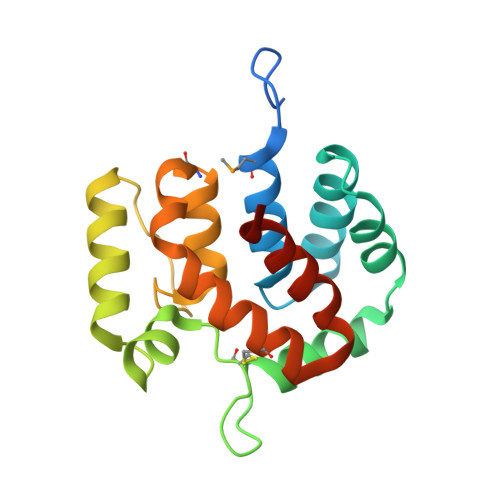An extremely SAD case: structure of a putative redox-enzyme maturation protein from Archaeoglobus fulgidus at 3.4 A resolution.
Kirillova, O., Chruszcz, M., Shumilin, I.A., Skarina, T., Gorodichtchenskaia, E., Cymborowski, M., Savchenko, A., Edwards, A., Minor, W.(2007) Acta Crystallogr D Biol Crystallogr 63: 348-354
- PubMed: 17327672
- DOI: https://doi.org/10.1107/S0907444906055065
- Primary Citation of Related Structures:
2O9X - PubMed Abstract:
This paper describes the crystal structure of AF0173, a putative redox-enzyme maturation protein (REMP) from Archaeoglobus fulgidus. The REMPs serve as chaperones in the maturation of extracytoplasmic oxidoreductases in archaea and bacteria. The all-helical subunits of AF0173 form a dimer arising from the interaction of residues located in a funnel-shaped cavity on one subunit surface with an uncut expression tag from the other subunit. This cavity is likely to represent a binding site for the twin-arginine motif that interacts with REMPs. The conservation of the overall fold in AF0173 and bacterial REMPs as well as the presence of conserved residues in their putative binding sites indicates that REMPs act in a similar manner in archaea and bacteria despite their limited sequence similarity. A model of the binding of the twin-arginine motif by AF0173 is suggested. The solution of the AF0173 structure by the single anomalous dispersion method represents an extreme case of SAD structure determination: low resolution (3.4 A), the absence of NCS and the presence of only two anomalously scattering atoms in the asymmetric unit. An unusually high solvent content (73%) turned out to be important for the success of the density-modification procedures.
- Department of Molecular Physiology and Biological Physics, University of Virginia, 1340 Jefferson Park Avenue, Charlottesville, VA 22908, USA.
Organizational Affiliation:

















